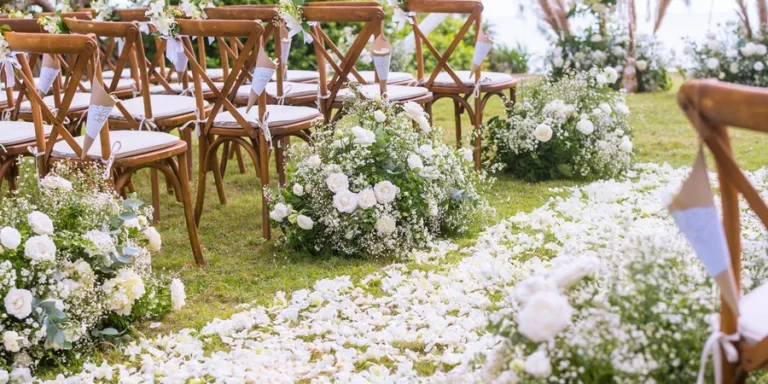Selecting the right wedding flowers for 2024 is crucial for creating memorable and visually stunning wedding celebrations. Wedding flowers not only add beauty and elegance but also convey sentiments and themes that resonate with couples and their guests. With a wide array of flowers available, each with its unique symbolism and seasonal availability, choosing the perfect blooms can elevate the ambiance of any wedding. Whether used in bouquets, centerpieces, or decorative arrangements, the right selection of wedding flowers can enhance the overall aesthetic, create lasting impressions, and ensure that the event is both visually and emotionally impactful.
Table of Contents
1. Main types and uses of wedding flowers
2. Market overview for wedding flowers in 2024
3. Key factors in selecting wedding flowers
4. Top wedding flower choices for 2024
Main types and uses of wedding flowers

As the calendar turns to 2024, the choices in wedding flowers not only reflect evolving tastes but also embody deeper symbolic meanings. Incorporating the right flowers into wedding settings goes beyond mere decoration; it’s about crafting an atmosphere that resonates with the event’s theme and the couple’s story.
Popular wedding flower types
Wedding flowers are a crucial element in creating the desired ambiance and theme for any wedding. Among the most popular choices are roses, lilies, orchids, and peonies. Each of these flowers carries unique symbolism and aesthetic appeal, making them suitable for various wedding styles.
Roses, often considered the quintessential wedding flower, symbolize love and passion. They come in a multitude of colors, each with its own meaning, allowing for versatile use in different wedding themes. Lilies, known for their elegance and purity, are another favored choice. Their striking appearance and fragrance make them ideal for formal weddings. Orchids, representing beauty and strength, add a touch of exotic sophistication. These flowers are perfect for modern and minimalist arrangements. Peonies, with their lush, full blooms, evoke romance and prosperity, making them a staple in many bridal bouquets and centerpieces.
Uses in wedding decor
The versatility of wedding flowers extends beyond bouquets and boutonnieres. They play a significant role in enhancing various elements of the wedding decor. Bouquets are the most personal use of flowers, carried by the bride and bridesmaids, often reflecting the overall color scheme and theme. Centerpieces are essential for decorating reception tables, setting the tone for the dinner or reception. These arrangements can vary from simple, single-flower vases to elaborate floral sculptures.
Altar arrangements create a focal point for the ceremony, often reflecting the grandeur and formality of the event. Aisle markers, typically smaller arrangements, add beauty to the procession path, while floral arches provide a stunning backdrop for the couple’s vows. Additionally, flowers can be used in less traditional ways, such as hanging installations or as part of the wedding cake decoration, adding layers of beauty and fragrance to the event.
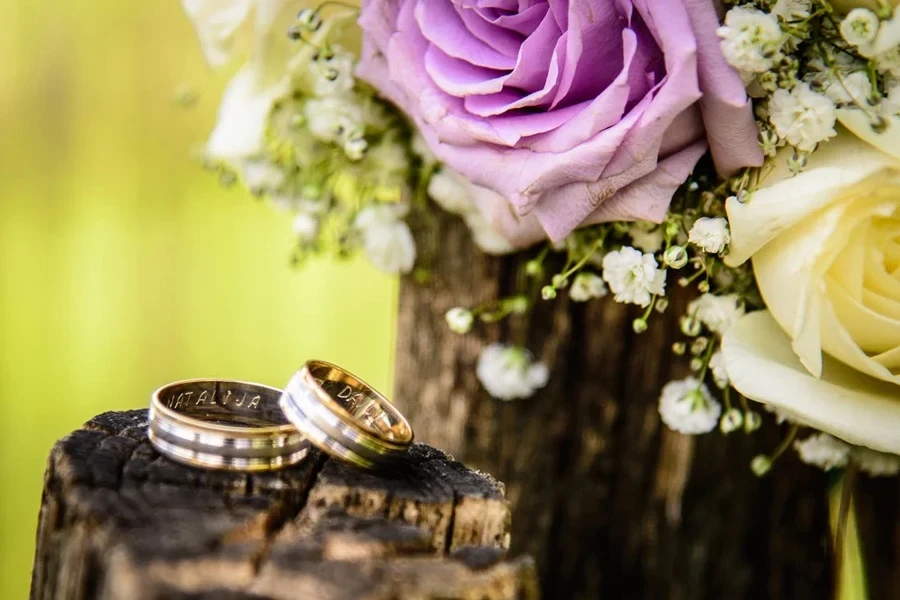
Seasonal availability and impact on choices
Choosing flowers that are in season not only ensures the best quality and freshness but also helps manage costs effectively. Flowers that are out of season typically need to be imported, increasing both the cost and the carbon footprint of the wedding.
Spring weddings often feature tulips, daffodils, and hyacinths, which are abundant during this season. Summer weddings can take advantage of the wide availability of roses, dahlias, and sunflowers. Autumn weddings might incorporate chrysanthemums, marigolds, and dahlias in rich, warm colors. Winter weddings, while more limited, can still showcase elegant choices like amaryllis, camellias, and hellebores.
Opting for in-season flowers not only aligns with sustainable practices but also supports local growers and ensures that the flowers are at their peak bloom, adding natural beauty to the wedding decor. Additionally, using seasonal blooms can inspire creativity in arrangements, as florists can incorporate a variety of textures and colors unique to each season.
By understanding the different types of wedding flowers, their uses, and the importance of seasonal availability, professionals can make informed decisions to create stunning floral arrangements that enhance the overall aesthetic and experience of any wedding.
Market overview for wedding flowers in 2024
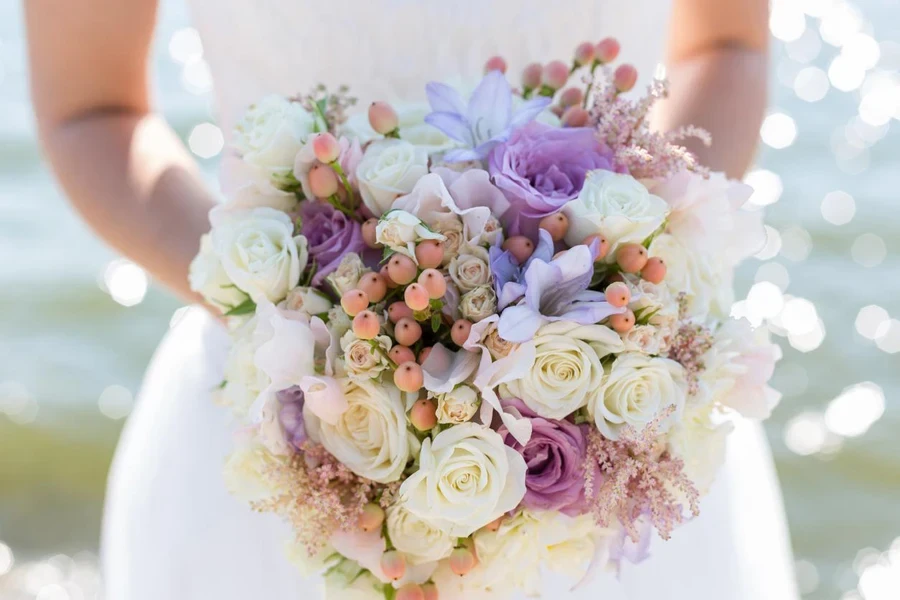
Market trends and statistics
The wedding flower market in 2024 continues to reflect evolving preferences and economic influences. According to industry data, couples typically allocate around 8% of their total wedding budget to flowers. This spending varies based on geographic location, the types of flowers chosen, and the overall wedding budget. For instance, high-demand flowers such as peonies or exotic orchids can significantly increase costs, especially if they are out of season.
Recent trends indicate a growing preference for sustainable and locally sourced flowers. This shift is partly driven by increased environmental awareness and the desire to support local growers. Additionally, there has been a notable rise in the popularity of personalized floral arrangements that reflect the couple’s unique tastes and cultural backgrounds. This trend is evident in the variety of colors, styles, and flower types chosen for different wedding elements, from bouquets to centerpieces and altar arrangements.
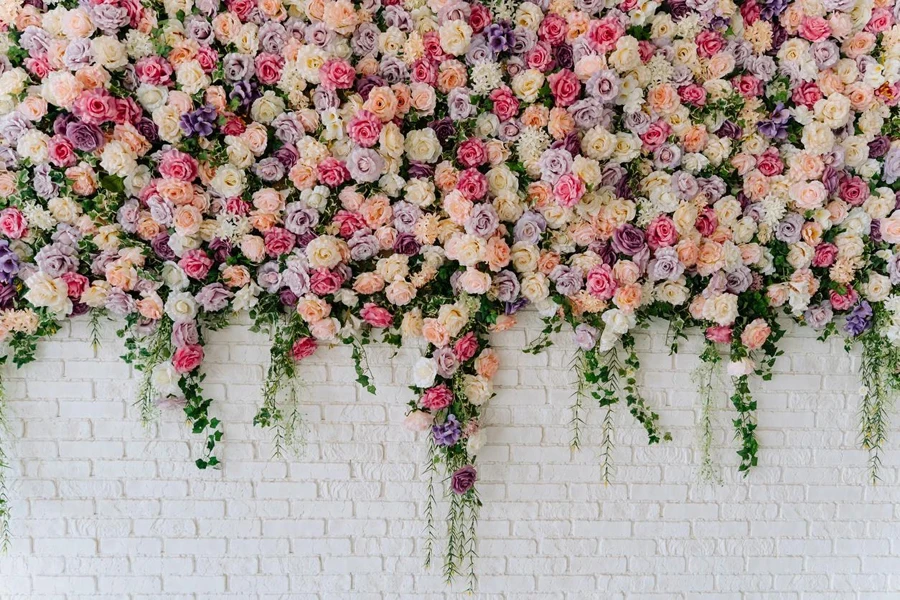
Influences on the market
Several factors influence the wedding flower market. Economic conditions play a crucial role, as fluctuations in disposable income and economic stability directly affect wedding budgets and spending on luxury items like flowers. In times of economic downturn, couples may opt for more cost-effective options or reduce the scale of floral arrangements.
Seasonal trends also significantly impact the market. Flowers that are in season are generally more affordable and of higher quality, leading many couples to select blooms that are readily available during their wedding month. For example, spring weddings often feature tulips and daffodils, while autumn weddings might incorporate chrysanthemums and marigolds. Florists often recommend in-season flowers not only for their cost-effectiveness but also for their superior freshness and vibrancy.
Popular wedding themes and cultural influences further shape flower choices. Themes like rustic, boho-chic, and vintage continue to be popular, each requiring specific types of flowers and arrangements to achieve the desired aesthetic. For instance, boho-chic weddings might favor wildflowers and greenery, while vintage weddings often include classic blooms like roses and peonies. Cultural traditions also play a role, with certain flowers holding significant meanings and being preferred for symbolic reasons.
Understanding these market dynamics is essential for professionals in the wedding industry. By staying informed about trends, economic influences, and seasonal availability, businesses can better cater to the diverse needs and preferences of their clients, ensuring that each wedding is beautifully and thoughtfully adorned with the perfect floral arrangements.
Key factors in selecting wedding flowers
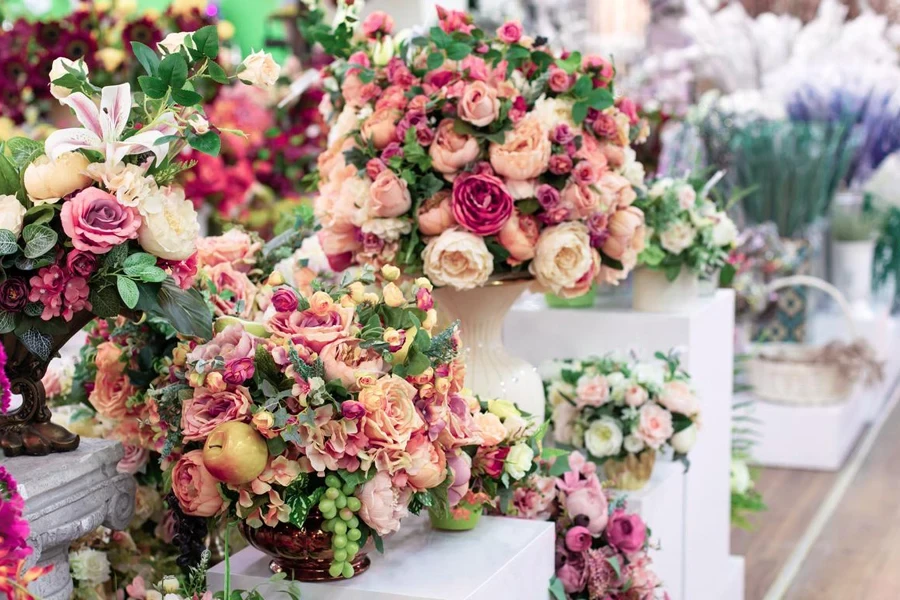
Budget considerations
Allocating the right percentage of the wedding budget to flowers is essential for achieving a balance between cost and aesthetic appeal. Industry experts suggest that couples typically spend about 8% of their total wedding budget on flowers. This percentage can vary based on factors such as the wedding location, the types of flowers chosen, and the overall budget. For example, high-end flowers like peonies or orchids can significantly increase costs, especially if they are out of season and need to be imported.
It’s important to establish a clear budget early in the planning process. This allows for realistic discussions with florists about what can be achieved within that financial framework. Florists can offer creative solutions to maximize the budget, such as using in-season flowers, which are generally more affordable and available in better condition. Additionally, prioritizing floral elements, such as bouquets and centerpieces over less essential decor, can help manage costs effectively.
Venue and theme alignment
Matching floral arrangements to the wedding venue and overall theme is another critical factor in selecting wedding flowers. The venue’s size, layout, and ambiance should guide the choice of flowers and arrangements. For instance, a large, opulent ballroom might require grand, towering floral displays to complement the space, whereas a rustic barn might be better suited to simple, earthy arrangements featuring wildflowers and greenery.
The wedding theme also plays a significant role in flower selection. For example, a vintage-themed wedding might incorporate classic flowers such as roses and peonies, while a modern, minimalist wedding could feature sleek, architectural blooms like calla lilies and anthuriums. Ensuring that the floral arrangements enhance and reflect the wedding theme creates a cohesive and visually appealing event.
Discussing the venue and theme with the florist helps to align their creative vision with the couple’s preferences. Florists can provide valuable insights into which flowers and arrangements will best suit the venue and theme, ensuring a harmonious overall design.
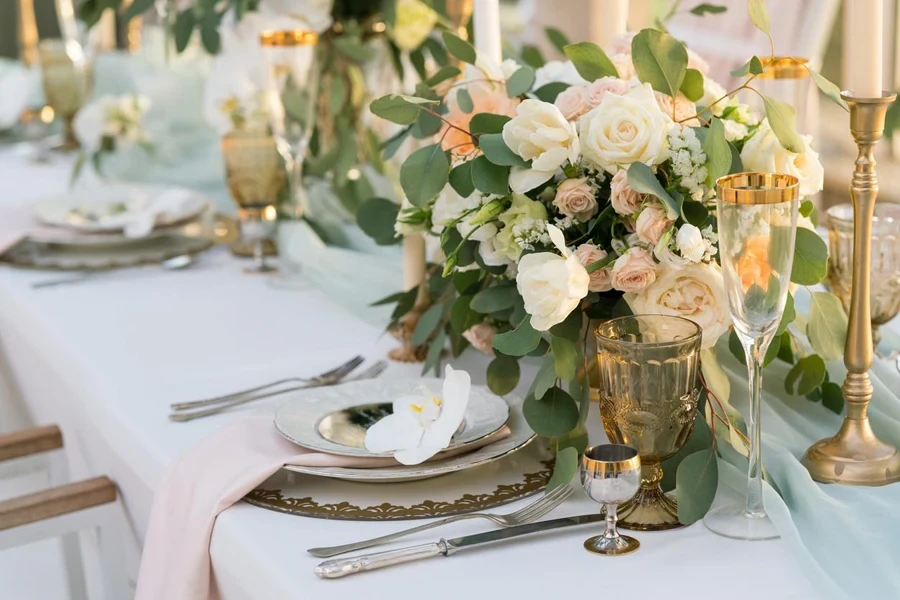
Personalization and symbolism
Incorporating meaningful flowers and personal touches adds a unique and sentimental dimension to wedding floral arrangements. Flowers have long been used to convey emotions and messages, and understanding their symbolism can enhance the personalization of the wedding decor. For instance, red roses symbolize love and passion, while lilies represent purity and innocence. Orchids are often associated with beauty and strength.
Couples can personalize their wedding flowers by choosing blooms that hold special significance to them or their families. This might include using the same types of flowers that were present at their parents’ weddings or selecting blooms that are meaningful in their culture or heritage. Additionally, personal touches such as wrapping the bouquet with a family heirloom ribbon or incorporating charms or mementos can add a layer of sentimental value.
The personalization of wedding flowers not only enhances their aesthetic appeal but also imbues the event with deeper emotional resonance. Florists can assist in selecting flowers that align with the couple’s story and values, creating arrangements that are both beautiful and meaningful.
Top wedding flower choices for 2024
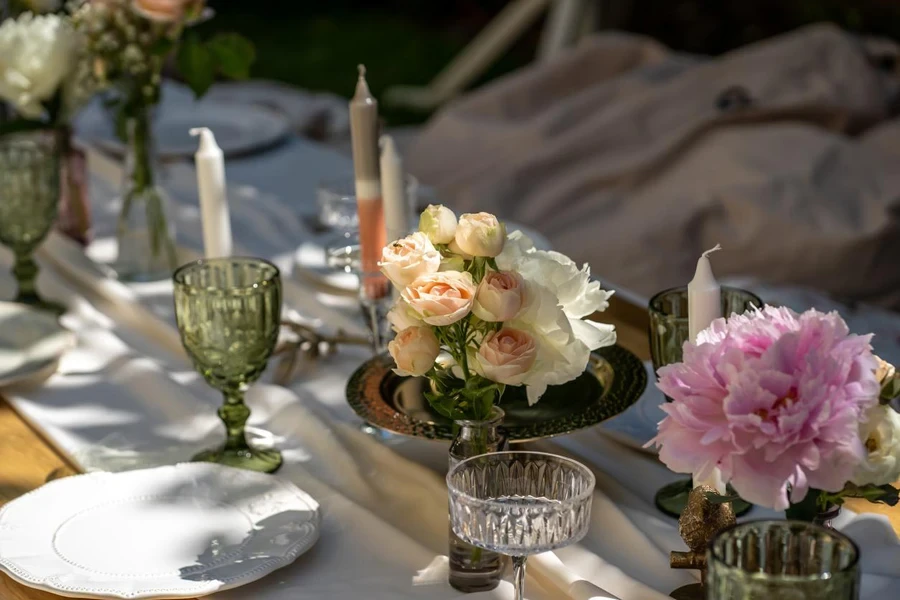
Best flowers for different seasons
Selecting the right flowers for each season ensures that they are in their prime, both in terms of availability and quality. For spring weddings, popular choices include tulips, daffodils, and hyacinths, which symbolize renewal and new beginnings. These flowers are vibrant and bring a fresh, cheerful atmosphere to wedding decor.
Summer weddings often feature roses, dahlias, and sunflowers. Roses, with their timeless beauty, are a staple, while dahlias add depth and variety in color and form. Sunflowers, with their bold and bright appearance, are perfect for outdoor summer weddings, adding a touch of warmth and happiness.
Autumn weddings benefit from the rich hues of chrysanthemums, marigolds, and dahlias. These flowers embody the season’s warmth and complement rustic and vintage themes. Chrysanthemums are particularly valued for their variety and durability, making them ideal for elaborate arrangements.
Winter weddings can be challenging due to limited flower availability, but options like amaryllis, camellias, and hellebores thrive during this season. Amaryllis, with its striking and large blooms, adds a dramatic touch, while camellias and hellebores bring a delicate elegance suitable for winter themes.

Leading floral arrangement styles
Floral arrangement styles play a crucial role in defining the wedding’s aesthetic. Classic arrangements, characterized by symmetrical and formal designs, often feature roses, peonies, and lilies. These arrangements are timeless and exude sophistication, suitable for traditional weddings.
Modern arrangements, on the other hand, utilize sleek lines and minimalistic designs. Flowers like calla lilies, orchids, and anthuriums are popular in modern settings due to their unique shapes and contemporary appeal. These arrangements often incorporate unusual color palettes and bold textures.
Rustic arrangements embrace a more natural and relaxed style, often incorporating wildflowers, greenery, and elements like burlap and twine. Flowers such as sunflowers, daisies, and lavender are commonly used to achieve this look. Rustic arrangements are perfect for barn or outdoor weddings, offering a charming and laid-back atmosphere.
Boho-chic arrangements are known for their eclectic and whimsical style. These arrangements blend various flowers, colors, and textures to create a free-spirited and artistic vibe. Popular flowers include pampas grass, protea, and anemones, often combined with lush greenery. Boho-chic styles are versatile and can be tailored to both indoor and outdoor venues.
Expert picks and advice
Florists recommend staying updated on trends while also considering personal preferences and seasonal availability. For 2024, expert recommendations include a mix of classic and innovative choices. Peonies remain a favorite due to their lush blooms and romantic appeal. They are especially popular in spring and early summer weddings.
Roses continue to be a top choice for their versatility and variety. Garden roses, in particular, offer a vintage charm and are suitable for both classic and rustic themes. For a more modern touch, anthuriums and orchids are recommended for their unique shapes and vibrant colors.
Sustainable and locally sourced flowers are increasingly popular, aligning with the growing trend of eco-conscious weddings. Florists suggest incorporating native flowers and greenery to reduce environmental impact and support local growers. This approach not only benefits the environment but also ensures the freshest and most vibrant blooms.
Personalization is key in 2024, with couples opting to include flowers that hold personal significance. This might involve choosing blooms that have special meanings or were part of family traditions. Florists advise working closely with clients to understand their stories and preferences, ensuring that the floral arrangements reflect their unique journey and style.
By considering these expert picks and trends, wedding planners and florists can create stunning floral arrangements that align with the latest styles and meet the personal preferences of the couple, ensuring a memorable and beautiful wedding day.
Conclusion
The 2024 wedding season underscores the importance of selecting flowers that not only enhance the aesthetics and ambiance of weddings but also reflect an informed approach to sustainability and market trends. With the global wedding flowers market projected to expand significantly, choices like traditional roses, contemporary orchids, and unique proteas provide diverse options to match any wedding theme. Professionals involved in floral procurement and design are encouraged to adapt these insights, ensuring each selection is both beautiful and strategically aligned with current trends and client desires.
